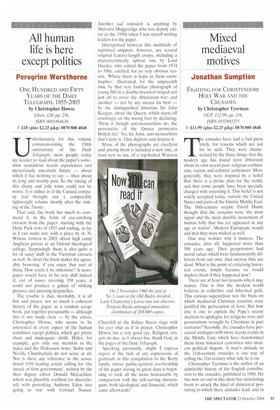All human life is here except politics
Peregrine Worsthorne
ONE HUNDRED AND FIFTY YEARS OF THE DAILY TELEGRAPH, 1855-2005 by Christopher Howse Eburv,L20, pp. 256, ISBN 0091894638 () ┬Ż18 (plus ┬Ż2.25 p&p) 0870 800 4848 Unfortunately for this volume commemorating the 150th anniversary of the Daily Telegraph, most people today are keener to read about the paper's somewhat scandalous recent experiences and mysteriously uncertain future ŌĆö about which it has nothing to say ŌĆö than about its long and worthy past. So the timing of this chatty and jolly tome could not be worse. It is rather as if the Cunard company had brought out a comparably lightweight volume shortly after the sinking of the Titanic.
That said, the book has much to commend it, in the form of eye-catching extracts from the paper, starting with the Hyde Park riots of 1855 and ending, as far as I can make out, with a piece by A. N. Wilson, written in 2003, about high camp Anglican priests at an Oxford theological college. Surprisingly there is also quite a lot of saucy stuff in the Victorian extracts as well. In short the book makes for agreeable browsing, if you enjoy that sort of thing. How could it be otherwise? A newspaper would have to be very dull indeed if, out of issues covering 150 years, it could not produce a galaxy of striking pictures and amusing despatches.
The trouble is that, inevitably, it is all bits and pieces: not so much a coherent history of the paper as a random scrapbook put together presumably ŌĆö although this is not made clear ŌĆö by the editor, Christopher Howse, who seems to be interested in every aspect of the human condition except politics, which get pretty short and inadequate shrift. Hitler, for example, gets only one mention in the index and the Holocaust none; Stalin and Neville Chamberlain do not score at all. Nor is there any reference to the sensational 1956 leading article calling for 'the smack of firm government', written by the then deputy editor Donald McLachlan, which was plausibly credited (or discredited) with provoking Anthony Eden into going to war with Colonel Nasser. Another sad omission is anything by Malcolm Muggeridge who was deputy editor in the 1950s when I was myself writing leaders for the paper.
Interspersed between this multitude of reprinted snippets, however, are several original feature-length essays, including a characteristically upbeat one by Lord Deedes, who edited the paper from 1974 to 1986, entitled, for no very obvious reason, 'Where there is hope in these catastrophes', illustrated, for the umpteenth time by that very familiar photograph of young Bill in a double-breasted striped suit just off to cover the Abyssinian war; and another ŌĆö not by any means his best ŌĆö by the distinguished historian Sir John Keegan, about the Queen, which starts off crashingly on the wrong foot by declaring: 'Deny it though anti-monarchists do, the personality of the Queen permeates British life,' No, Sir John, anti-monarchists don't deny it. 'hey deplore and despise it.
Many of the photographs are excellent and among them is included a new one, at least new to me, of a top-hatted Winston Churchill at the Sidney Street siege with his eyes shut as if in prayer. Christopher Howse has a very good eye. Religion, too, gets its due, as it always has, thank God, in the pages of the Daily Telegraph.
Speaking personally, might I express regret at the lack of any expressions of gratitude in this compilation to the Berry family whose public-spirited overlordship of the paper during its great days is beginning to look all the more honourable by comparison with the self-serving shenanigans, both ideological and financial, which came afterwards?
























































































 Previous page
Previous page